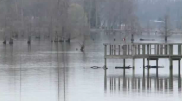Windscale Fire Disaster: A Brief History
During the post-WWII nuclear arms race, nations worldwide amped up their nuclear energy production to use not only for power, but for weapons as well. Great Britain joined the trend by constructing the Windscale power plant as an answer to the United States' Hanford reactor in Benton County, Wash., which provided the plutonium for the world's first atomic test in 1945.
However, nearly a decade later, the plant would meet its end. On October 10, 1957, an overheated reactor set the plant ablaze for over 16 hours, with officials scrambling to control the physical and political damage.
The fire destroyed preventative and protective barriers, resulting in a burst of radioactive contamination that drifted across northern Europe. Fallout was found in counties as far as Norway, Belgium and Germany.
Once the power plant was decommissioned, the production of plutonium declined significantly in Britain, which delayed efforts to develop stronger nuclear weapons. This caused a major reorganization of Britain's Atomic Energy Authority. A portion of the Windscale site was later renamed as Sellafield.
The UK government blamed the workers' incompetence for the disaster, rather than lack of efficient management or effective procedural policy. The latter reasons were later revealed to be primary factors in the incident.
In 1974, Britain's nuclear industry released a report that claimed workers at Windscale were healthier than the general population. What the report did not say, however, was that nuclear plant employees are screened for health; elderly, ill, or disabled persons were not hired at the plant.
In the '80s, it was discovered that Harold Macmillan, the prime minister of the UK at the time, suppressed a report on Windscale, as he claimed the plant's unsafe conditions would be used against him by opponents of nuclear energy.
Recent analyses of the disaster suggest that the plant may have been doomed from the start. Vic Goodwin, who was a trainee reactor physicist working for Windscale in 1957, told the Telegraph that he never liked what he saw, calling the design "dodgy".
As reported by the AP, Windscale was considered "primitive" even in the '50s when nuclear energy was still very young. It was also the only plant in Britain that operated with an open chimney, which was considered an inferior design because contamination could easily escape.
And the radioactive contamination that escaped did wreak havoc. In the months after the Windscale Fire, a state of emergency was declared in the 500 km area around the plant. Livestock was quarantined; milk and dairy products were not considered safe.
Even with those precautions, many found the radiation inescapable. In Britain alone, it is estimated to have caused 240 cancers; half of them have since become fatal.
Cleanup would take a full 10 years and eventually cost at least $30 million, however its memory still remains and new discoveries continue. Fallout measurements were reassessed in 2007, showing that the actual amount of contamination was at twice the level that it was previously thought to be.





